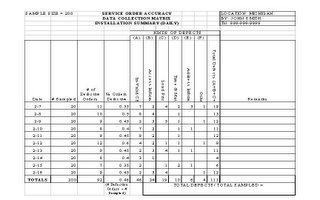One of the most overlooked criteria’s required prior to data collection activities is to create an “Operational Definition.
”An Operational Definition is a precise description that tells how to get a value for the characteristic you are trying to measure. It includes what something is and how it is to be measured. The key word is characteristic (s).
It is also important to understand that you may need a separate definition for each subject area. For example, Employee “A” may have a different definition than Employee “B”. The purpose of an Operational Definition is two-fold:- 1) To remove uncertainty so everyone has the same understanding- 2) To make sure that no matter who does the measuring, the results are always the same.
The following is an example Operational Definition I used when I worked in the Voucher Department:
“An error-free expense report includes receipts for all items on the Expense Form over $25.00 and does not include any receipts for items not included on the Expense Form. There are no math errors and expenses are coded properly.”
or,
“The starting time to measure customer response time is when the customer enters our store and when the customer leaves.”Think of the Operational Definition in Data Collection as you would the Problem Statement for Root Cause Analysis. Both should be stratified (i.e., broken down/categorized) to provide a focus that can be measured and understood by all involved. Without this we will probably conduct meaningless data collection studies and reports (unfortunately I’ve done that many times when pressured for data).
1. Clarify Data Collection goals
2. Develop an Operational Definition
3. Test for Data Consistency
By following these guidelines you will not only improve your data collection activities, you will also reduce cycle time in analyzing and displaying your data with the appropriate graphs and charts.
p/s - When you can measure what you are speaking about and express it in numbers, facts, theory or application, then you know something about it, but when you cannot measure it, envision it, or provide meaningful information about it, or if you cannot express it in numbers, your knowledge or so called expertise is of an insufficient and unacceptable type.
Example Data Collection Forms
1) This form can be used for collecting facts and information from a supplier, process owner or customer. Getting this information and data upfront allows the data collector to create high level end-to-end process flows, data collection sheets, further analysis, etc...
2) This form is used to not only collect data and information but it also serves in developing a sound operational definition and plan to data collecting.
3) The data collection from below is an example for collecting data on "Service Order Accuracy." When input orders are involved this is an excellent starting spot for correcting downstream problems, especially if the order travels through multiple departments. Do not forget the Sales Department(regardless of what they say) who usually are the first step in filling out the order.

Note: The data used above is "attribute" (i.e., counting, percentages) type data. This data can be useful in setting up Pareto Charts and for creating control charts (p, np, c, u).
qualityg always recommends a statistician before setting up and analyzing control charts.

No comments:
Post a Comment